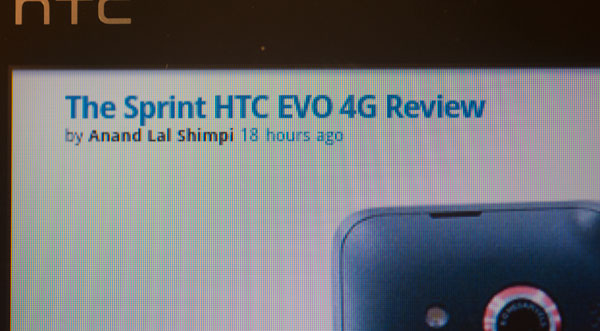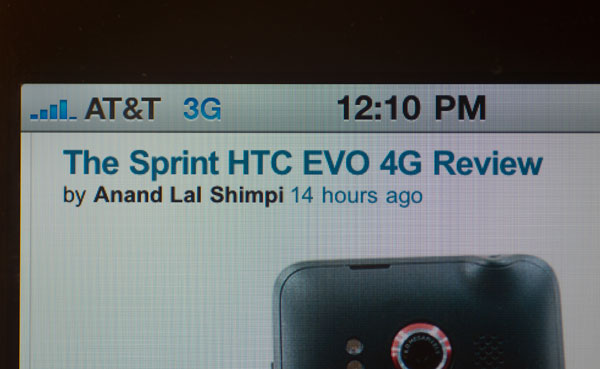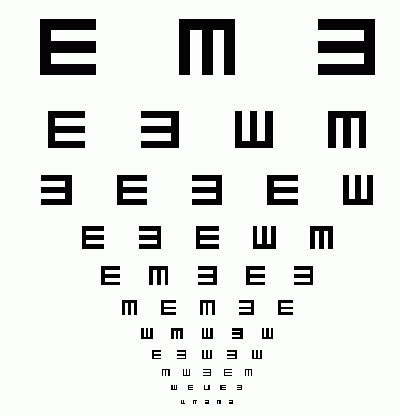Apple's iPhone 4: Thoroughly Reviewed
by Brian Klug & Anand Lal Shimpi on June 30, 2010 4:06 AM EST- Posted in
- Smartphones
- Apple
- iPhone 4
- Gadgets
- Mobile
Screen - Retina Display
Right out of the box, the iPhone 4's new 326 PPI, 960x640, 3.5" display is arguably the single most striking change the new iPhone brings. In a word, it's dazzling. Text and high res images look amazingly sharp on the iPhone 4’s retina display. It’s an improvement over the 800 x 480 AMOLED screens that have been shipping on most Android phones. But if you’re comparing it to an iPhone 3GS the difference is huge.
 |
 |
|
iPhone 3GS
|
iPhone 4
|

Text on the Google Nexus One

Text on the iPhone 4
The dot pitch is truly remarkable, so much so that Apple makes the claim that their display outresolves the human eye; its advertised ability to do so has earned it a new Apple tradename, "retina display."

Text on the HTC EVO 4

Text on the iPhone 4

AnandTech Logo on the EVO 4G

AnandTech Logo on the iPhone 4
Immediately after hearing Apple's claim that the Retina Display outresolves the human eye, I snapped into optics mode and crunched the numbers, and tweeted that the results were valid.
In the days that followed, there was considerable debate about the validity of Apple's claims. However, nearly all of the debate really just hinged on a debate over angular resolution of the human eye, and a little more over viewing distance. They're both entirely conventions.
As you've probably discovered by now, the human eye resolution can really only be characterized in angular subtense. Hold something closer to your eye, and you can see smaller features better (in theory), move it further away, and you can't make out small spatial details. The minimum angle visible with the human eye is the angle at which features (for the most common definition, a black and white square wave) stop being visible, and are indistinguishable from each other.
Most measures of visual acuity test with this implicitly - the Snellen eye chart's use of the capital "E" is literally a perfect example, which has given rise to a "tumbling E" eye chart. At twenty feet, the capital E subtends 5 minutes of arc, and conveniently has five half cycles of white to black (from top to bottom). So 20/20 implicitly implies an angular resolution of 1 arcminute (1/60 degrees).

As an Optical Sciences and Engineering undergrad, I've had 1 arcminute drilled into my head more times than I can count as being the "normal" angular resolution of the human eye system. In practice, this is 20/20 vision, which is "normal," yet not perhaps the absolute maximum for human perfection. We can play games of course and argue that a small subset of the population has better than normal uncorrected vision, and thus an angular resolution of below 1 arcminute. I have above average uncorrected vision, which I've measured to be 20/15 on average, giving an angular resolution of approximately 0.75 arcminutes. Of course, the definitions stem from the spacing of cones in the fovea, the highest resolution part of the retina.
The other informational quantity needed to test the Retina Display claims is viewing distance. Again, there's a commonly agreed upon convention - standard viewing distance is considered to be 1 foot. This is another drilled into my brain number tossed around for comfortable viewing and reading. In practice, you can focus on objects much closer to your eye - this is called the near point and is often given as 10 inches, though as you get closer you increase strain aren't likely to keep it here.

Maybe not exactly the limit, but close enough.
Given the two most common standards tossed around, 1 arcminute and 12 inches, do the math out and you'll arrive at around 286 pixels per inch as the limit for eye resolving power, comfortably below the 326 on the Retina Display. Move to 0.75 arcminutes at 12 inches, and it's 382 pixels per inch, higher than the Retina Display. Honestly, I can't see the pixels at 12 inches.
Of course, the real story is even more complicated. Remember how the definition comes with the implicit assumption that we're dealing with a square wave pattern from white to black? That's a factor too - the contrast of the two pixels. Lower the contrast, and the eye's ability to pick out features decreases even more. So far, everything we've talked about has been first order, and without aberrations. Toss in spherical and astigmatism, two aberrations common to the eye system, and eye performance drops way more.
The human eye system is actually pretty poor, and shockingly easy to outresolve. In fact, if you saw the image your eye forms on your retina, you'd likely be appalled; it's your brain that makes the system usable. But at the end of the day, Apple's claims that the display outresolves the human eye are good enough for us.










270 Comments
View All Comments
bplewis24 - Monday, July 12, 2010 - link
Consumer Reports confirms what I have commented on earlier about this article: that the "best case scenario" testing of one phone is clearly an attempt to excuse away this clear design flaw in a biased review. See the article here: http://blogs.consumerreports.org/electronics/2010/... .And watch the video. This testing was done in a controlled environment with an RF Isolation Chamber that is impervious to outside radio signals. I suggest you guys stop misleading the tech nerd population with this review now, and revise it.
Brandon
plastic_avatar - Monday, July 12, 2010 - link
How can you not respect the research of someone who slides in an apt geek reference?zholy - Tuesday, July 13, 2010 - link
Only Apple can release a product with such a design flaw and respond to complaints with either "you're holding it wrong" or "buy another product to make it work correctly". Any other company would have their product returned in droves, Mac fanatics just say "ok"Hengie2000 - Saturday, July 17, 2010 - link
Help! I am a wireless tech that uses field test daily to survey in building wireless projects, but the iphone 4 or 4.0 upgrade lost that capability. I am willing to pay for someone to make a field test app or follow the steps that Brian and Anand have listed in this story. Is there any way to reach these guys for more details to get field test running on the iphone4? Does this give full field test menus or only replaces the signal bars with decibels?Stang289 - Monday, July 26, 2010 - link
It would be great if you had Palm Pre Plus and Pixi Plus performance numbers included in smartphone reviews. I would like to see how they stack up against other smartphones.marxster - Thursday, September 9, 2010 - link
...after all that, I'll give you my real world experience. We have a 3Gs and a 4 in our household. The 3Gs always shows more bars and does not drop calls at all while my iPhone 4 does drop calls and has less bars.We live far away from the closest tower and the iphone 4 doesn't ever get better reception here than -103db.
I'm now afraid to receive calls because I know they'll be dropped. Makes my phone useless.
I should say that both phones are on the latest iOS version and there isn't much of a difference whether I use a case or not.
By the way, please explain this to me. Why did Apple bother to spend millions of dollars shipping out cases when they clearly don't get rid of the problem. When I cup my phone with the case on, the bars drop just the same as without.
MisterQED - Wednesday, October 20, 2010 - link
I am not a member of the “tin foil hat” crowd, I’m a guy with a physics degree and a Ham license, so I know a bit about radios. What I am about to point out seems so obvious to me, but I have never heard it discussed anywhere. Your article discusses the effects of having a exposed antenna as it effects phone reception, but that misses the main point, this is a receiving and transmitting antenna. Having skin contact with a transmitting antenna is not safe. Allow me to explain my thought process and tell me if I have a flaw in my logic.1) Constant irritation causes cancer. Whether it is fiberglass fibers, silica dust or coal dust in our lungs, to UV radiation from skin exposed to the sun, if you irritate an area consistently for long periods of time, you are just asking for cancer.
2) RF radiation from most phones is a subject of worry and present discussion, but it doesn’t worry me. RF radiation is a worry because it will cause electrical conduction thru body tissue. This would be an irritation and consistent irritation can lead to cancer. RF radiation from most phones has two methods of conduction, capacitive and inductive.
a) Capacitive needs: a sizable area, small dielectric distances and high frequencies. Cell phones have the high frequencies, but all other designs keep minimal gaps between antennas and the operator’s skin. Also the operator’s finger tips provide a rather small area to support capacitive conductance.
b) Inductive conduction needs frequency matched radiators to allow conduction i.e. a good antenna on each end. Body parts make poor antennas, and bodily dimensions generally don’t match the proportions of ideal radiators, so inductive conduction isn’t really a worry.
3) iPhone 4s, unlike any previous device, allow a third and a magnitude more effective connection between an operator and a transmitting antenna, a resistive connection. All a resistive connection needs is a low resistance, which skin has when sweaty or damp and the antenna has if it is not covered by a non-conductive coating. To add insult to injury, this contact de-tunes the antenna making it less efficient. This inefficiency causes the transmitter to up the power output as cell phones work on a “yell loud enough to be heard” system, so the worse the reception the more power the phone will pump into the antenna to be able to communicate with the cell tower.
So unless you can show me where my logic has lead me astray, I would expect that in the future some percentage of the population that use an iPhone without a case may find a small possibly cancerous mole forming on one of their fingertips.
That is a bigger problem than some dropped calls, so why didn’t you mention it.
smithpercy - Sunday, November 14, 2010 - link
Does this mean that I could cold weld a suitable socket to the gsm antenna side strip to allow a patch cable to an external antenna and get reception in the very marginal areas that I spend most of my time in?? I know that the shield would have to be grounded but that could be done thru one of the other connectors. I understand that would void the warranty, and give apple a conniption fit but that is their problem.keri - Thursday, February 24, 2011 - link
serious question here.jessicacoles - Saturday, December 12, 2020 - link
https://reviewsicon.com/